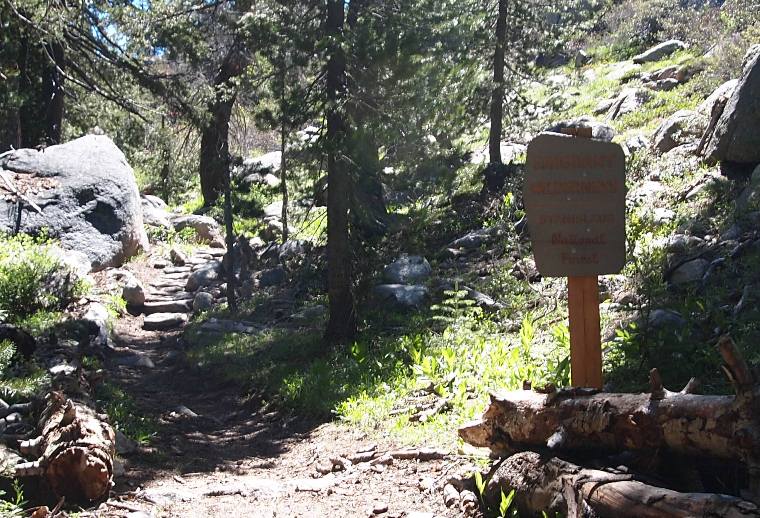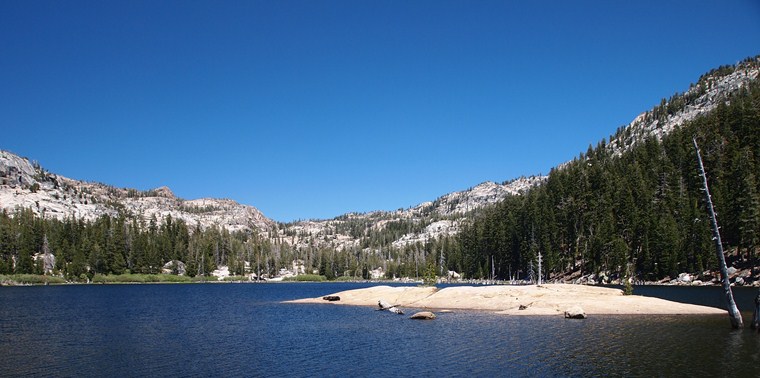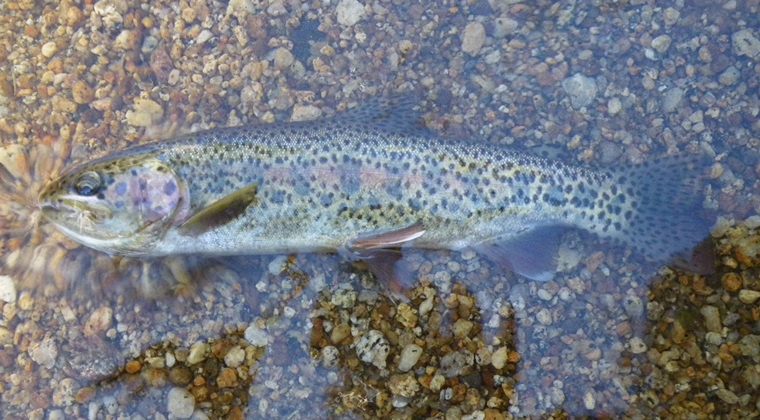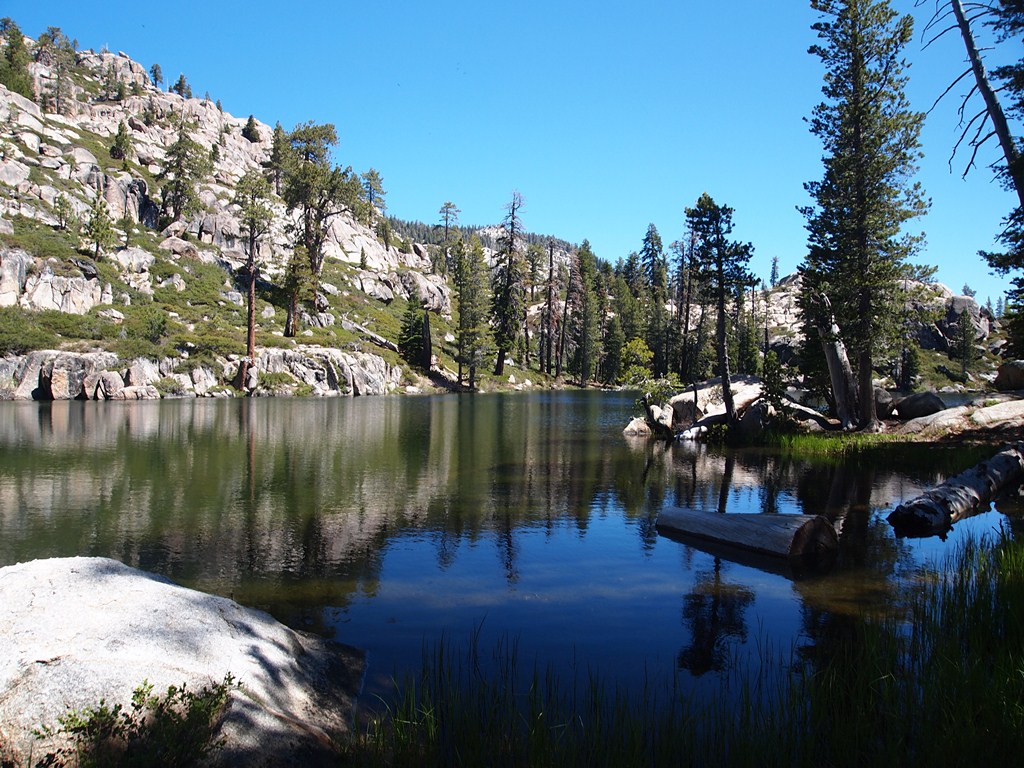|
|
|
|
|
Weather: Sunny and Mild For the first time in nearly a decade, the ďfirst weekend in June- Camp Lake scenarioĒ was played out. Camp Lake has been dead for many, many years due to the cessation of stocking to many of the Emigrant Wilderness lakes. I caught my last fish there at what I believe to be the end of the cycle in 2002. It was my largest fish yet. Occasionally Iíd still hike the Crabtree trailhead but would pay Camp minimal attention- some time spent searching for cruising fish and a few token casts before moving up the trail.
A couple of years ago Camp Lake went back on the DFG stocking list. I meant to fish it last year but didnít get a chance. This year the stars aligned and my schedule and the fishing conditions gave me the perfect opportunity to revisit Camp Lake as a primary destination. But had they restocked itÖÖ? I presumed that they did. It had gone back on the stocking list in 2010 and here I was two years later. Plenty of time for DFG to restock the lake and still within what I guess would be the limit of any hold over trout. (Brookies were planted in 1999 and 2000) There was one peculiar note on the stocking list, one thing that bothered me. They planned to stock the lake with Rainbow Trout. This didnít make sense to me. The lake had previously supported Brook Trout and the Brook Trout fared well. I donít know if they ever spawned in the lake, I doubt it. The Brook Trout caught in Camp were always of about the same size and winter and summer kills would ensure a limited population of fish. Iím not so sure that Rainbows would fare as well. A quick check of the DFG online records only states that Camp Lake went back on the stocking list in July of 2010 and does not provide any recent stocking data. It was a fast hike to the lake, just over 46 minutes, which is probably some sort of record for me. I was barely winded as I made the first and second steep ascents up the trail. In the past, these ascents usually required a bit of recovery during or at the top of each. Like no other year before, I'm happy to say Iím prepared for the upcoming backpacking season. I arrived at an empty lake, put my pack down and refueled as I peered into the water looking for fish. There were no fish to be seen- none at the fallen log at the outlet, none on the neighboring flat, none at the submerged log just up the trail and none off the drop off near the small weed bed, close to the big rock. It didnít look good. These were places in years past where we would always see cruising Brook Trout. Still grasping on to hope, I strung up my rod and worked the lake. This lake, like many lakes I guess, has areas that are a ďsureĒ thing with a properly presented fly. Or at least they used to be. I know these areas and fished these areas and the areas in between with techniques and patterns I knew worked in the past. This was never a particularly difficult place to catch fish. Nothing. A fellow fisherman passed me on his way back to the trailhead ďstick to the streamsĒ he said. I fished the lake until I was convinced that there were no fish and then started up the trail to Bear Lake. I hate to say it but for as many years as Iíve visited Bear, Iíve never fished the lake properly. Iíve never really fished the shoreline very hard. Iíve caught or folks Iíve been with have caught fish- Brown Trout, Rainbow Trout and Brook Trout from Bear but I donít know it as well as I should. I decided to rectify that a little bit. I started at the outlet like I usually do and could see the outlet pool teeming with fish. More fish than usual but also pretty small in size. Ignored the pool and concentrated instead on the plunge at the head. The run is teardrop shaped with a small plunge at the top surrounded by narrow overhanging granite. It widens out into an open and fairly exposed pool. Using my standard beadhead nymph, I made several casts along the granite. Nearly each cast was greeted with a grab but no solid hook ups. Repeated attempts eventually produced two 6 or 7 inches Brook Trout. The granite forms several cascading pools until it reaches the lake proper and I fished each pool quickly as I made my way to the flow control dam. The lake was crowded but to the left of the large boulder near the dam, I was able to squeeze in-between some swimming dogs and rock lounging people. I fished this spot because I knew it could produce fish and when it didnít, I decided to move along the shoreline in a clockwise direction.
Again, I had to navigate between the folks hanging out at the waters edge. This was good in a way as it forced me to take a higher route on the rocks than I might normally and allowed me a better vantage point for spotting trout. And spot trout I did. Three or four all cruising at the edge of a little cove. At first, I only saw the one fish. I rushed to the waters edge and made my first cast. The fish immediately spotted the fly and followed it until I recast. I cast out again and again the fish followed the fly. I made a slight change in retrieve (which I unfortunately canít remember) and the fish grabbed the fly. I missed the hook set. Concerned I missed my shot, I pulled my fly line in and watched the water. More fish came into view and I made another cast. My targeted fish started to follow the fly but a third smaller fish was going to intercept the fly fish. In an attempt to stop the smaller fish from snatching the fly I sped up the retrieve and out of nowhere shot an 11 inches Brookie. No need to set the hook on this one. That fish wanted the fly and all I needed to do is lift the rod. It was not long after landing my second fish that a crowd of fish catching hopefuls started to develop, it was time to move on. I say Iíve caught Rainbows at Bear Lake but the truth is, I canít remember catching Rainbows proper in the lake. Itís always the inlet which produces the Ďbows. I suspected with the crowds a large as they were that the inlet had already been hammered but ďwhat the heck, I might as well check it out.Ē The fish were sunning themselves in the low, clear water when I first approached. Typically itís the plunge pool that gets my attention, but that could wait. The inlet stream itself had plenty of fish holding in small pockets and shallow runs. I approached the stream systematically, casting to the fish in a shallow run below the plunge. The fish were stationed on the lip of the pool in a small pressure cushion. Boy were they easily spooked.
Itís interesting how in some places you can cast a fly line over some fish and get no reaction and in others, even if the line isnít directly overhead, the fish scatter. That was the case here and it proved a greater challenge than I was expecting. Anything that hit the water too hard, caused the fish to scatter, any bit of flyline over the water caused the fish to scatter, any dragging of the fly caused the fish to scatter. I just couldnít catch a break. In addition, if a fly had been followed and rejected once, it was useless casting it back up again. Even if the second drift was better. The fish had seen the fly and werenít interested in seeing it again. That said, there were some very actively feeding fish among the masses and I received great satisfaction when I got it right. After fishing the shallow pools for a while I moved to the large plunge pool. This pool forms a natural barrier which prevents all but the strongest fish from swimming upstream and while I was fishing the smaller pools, I could see fish after fish trying to swim up the small cascade- shades of the infamous Salmon running upstream and getting swatted at by Grizzlies scene. I didnít see any spawning fish or redds but it was definitely getting close to that time. From about 25 feet downstream, alongside the more shallow pools I fired cast after cast into the pool until I stopped catching fish on dry flies. When I switched to a nymph the fish went out of control. I couldnít keep them off the fly. It became one cast Ė one fish and some of the takes were beyond savage. It wasnít challenging fishing to say the least and not as satisfying as the sight fishing I did below but it was great fun and the kind of fishing I like to experience once a season, just for the fun factor. It was hoot! If you ever visit this area, I encourage you to catch and release and leave the harvesting to the kids. This is a great place for a kid's first fishing experience. There were lots of folks at Bear Lake, more than Iíve ever seen and many seemed not too experienced in the wilderness; Bearís that kind of place. Itís a quick, relatively easy hike into the wilderness and Iím sure serves as a first overnight backpacking trip for many folks. (You can only camp at Bear for one night.) Lastly, some beta for Crabtree Trailhead users, I passed lots of folks on the trail, all thinking that Emerald Lake would be a good choice of destination. Iíd hate to be the guy arriving there late in the day, hoping to find a campsite. Emerald Lake was one crowded place that weekendÖÖ 07/08 - Epilogue - Planting of rainbow fingerlings on Camp is scheduled to occur the week of July 8th.
Previous Emigrant Wilderness Chronicle Next John Muir Wilderness Chronicle
|





